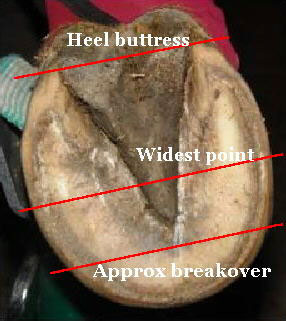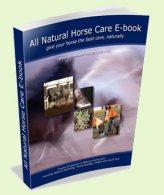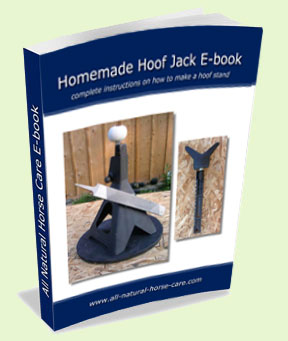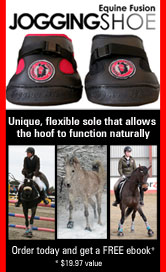The LIM Trim by Walter Friedrich
|
The LIM trim (Less is More) philosophy is that we should not blindly
follow someone else's idea of how it should look, but rather do as
little as possible and only what is absolutely necessary for each foot,
on the theory that it's quite capable of fixing itself when given half a
chance. Bottom line -- be careful to overdo nothing. |
I think that many of us do too much, too often to our horses' feet in the name of making them look like a feral's, on the theory that if the outside looks "right" then the inside must also be right. Thinking back over horses I've known, I realize that it's not at all uncommon for the "well"-trimmed and often-trimmed horse to be the lame one, while the horse whose feet are left pretty much alone seems to get along just fine.
I think it's incorrectly inferred by many of us who've learned from Strasser or KC or Jaime or others that we need to force, even micromanage, the feet to idealize their appearance if we want our horse barefoot and sound, when that's not at all what these people are trying to get across. With the exception of the appearance of the white line, how the outside looks does not guarantee that the inside is as it should be.
Here is exactly what comprises the LIM Trim
First, trim frequently. A three-week cycle is a good compromise between overworking your back or pocketbook and running the danger of letting hoof growth get away from you.
Second, at each trim study the feet on the ground before you pick one up. Make a mental note about what doesn't look quite right so you're sure to address it when you have hoof in hand. This is when you'll spot the existence of any flaring. Continue the study when you pick up the foot - the only tool you should have in your hand is your pick/brush, with your wire brush handy.
Clean off the bottom thoroughly, including the commisures, so you can see all foot and no dirt. Now look to determine the cause of any anomalies you saw before picking up, as well as the condition of the sole components. Don't rush into rasping or cutting (remember the motto of the LIM trim: "Less is More"), take a moment and study what you've got, then plan out your work. That includes locating the widest distance across the foot, the location of the breakover, and the location of the heel buttresses. Gene suggests you actually draw lines with a marking pen so you can see exactly what you've got. See the photo below for a roadmap of the sole. Keep the 65-35 ratio (or thereabouts) in mind - if you don't see it, determine why: have the buttresses worked their way forward since the last trim? Has the breakover disappeared or moved? Plan for your corrective routine.
|
Finally, go to the LIM trim. You're going to "fix" specific problems that you spotted during your evaluation phase, then give it the Old 1-2-3. That is, 1), take down wall all around to live sole plane, making sure the foot is balanced, 2) make sure the heel buttresses are where they belong according to the 65-35 concept. It means bring them back close to the location of the frog buttress, which isn't gonna change. Then 3), rocker the toe to support/induce proper breakover point and apply a mustang roll. |
 Hoof photo courtesy of Sossity Gargiulo |
When correcting hoof problems like pointy toes and underslung heels, while all the above applies, the wall needs special attention. Depending on the severity of any flaring, you may need to nip away the bottom of the wall. Some trimmers cut back the toe vertically. That's essentially the same as a strong rocker and mustang roll. The objective is to remove leverage from the extended wall digging into the ground. The advantage in applying the strong rocker/mustang roll is that you're in little danger of taking it back too far, but you may have to touch up the toe more often than every 3 weeks.
Some pertinent comments:
- First,
hinds generally don't get the toe rocker, but do get the mustang roll
and you need to make sure the toe wall is not left too long - you want
to support breakover where the foot wants it. Because of the difference
in shape between fores and hinds, the support ratio is probably closer
to 50-50 in the typical hinds.
- Don't touch the toe callous on any foot.
- You
may need to trim the bars with the knife if you're trimming to correct a
problem foot, but when you're trimming to maintain a good foot, the
bars should rarely, if ever, need knife attention.
- Normally, the
frogs don't need attention, but if they're stringy you can trim off the
raggedy stuff. If they're deteriorated, you can apply whatever treatment
you're using -- Kopertox, TTO or other.
- You can debride the sole if you wish, without cutting into the live sole itself.
Yes,
of course, the LIM trim is simple -- that's the point. Its essence is
that you do no more than the hoof calls for, you specifically ensure
properly lowered heels, you support proper breakover, you balance the
foot, and most importantly, you support the forces acting on the foot
while the horse moves so that it wants to stretch rather than contract.
The LIM trim allows the bars to remain straight and the frog, if it's
not suffering from a fungal infection, to fatten up and make initial
ground contact.
Return from the LIM trim to Natural Hoofcare
Please consider making a donation to help me keep this site going -
donations over $10 get a free ANHC ebook ($17.99 value)
Like the information
on this site?

Downloadable eBook now available containing all the information on this site - over 100 pages - in an easy to print and navigate offline version.
Click here for more information
Hoof Jack eBook

Downloadable eBook with detailed instructions and clear photos on how to make your own Hoof Jack.
Click here for more information





